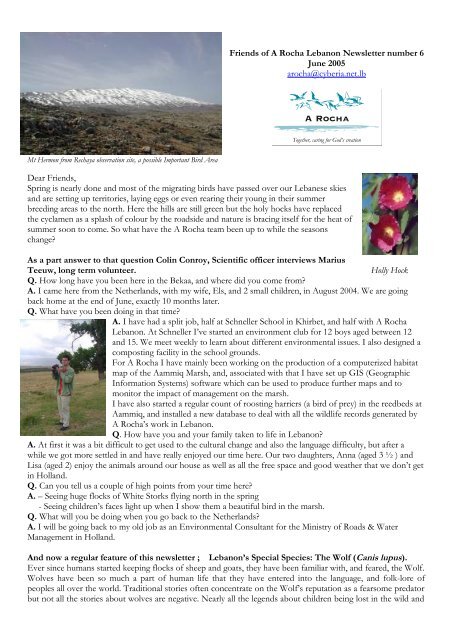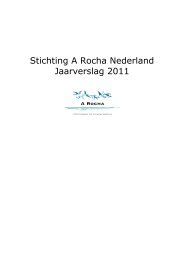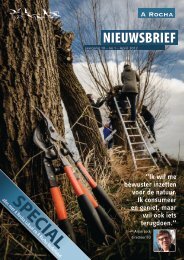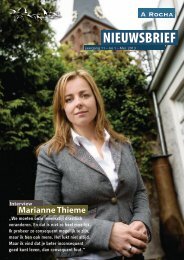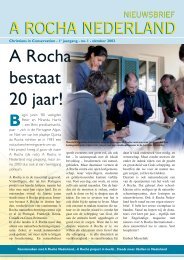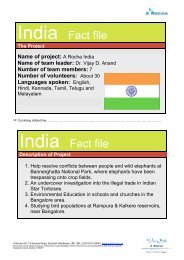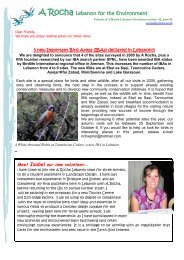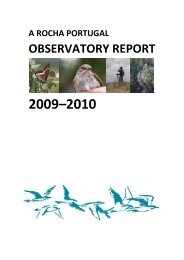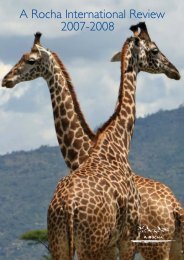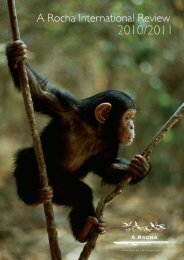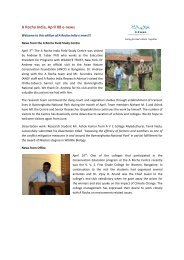Issue 6, June 2005 - A Rocha
Issue 6, June 2005 - A Rocha
Issue 6, June 2005 - A Rocha
You also want an ePaper? Increase the reach of your titles
YUMPU automatically turns print PDFs into web optimized ePapers that Google loves.
Mt Hermon from Rechaya observation site, a possible Important Bird Area<br />
Friends of A <strong>Rocha</strong> Lebanon Newsletter number 6<br />
<strong>June</strong> <strong>2005</strong><br />
arocha@cyberia.net.lb<br />
Together, caring for God’s creation<br />
Dear Friends,<br />
Spring is nearly done and most of the migrating birds have passed over our Lebanese skies<br />
and are setting up territories, laying eggs or even rearing their young in their summer<br />
breeding areas to the north. Here the hills are still green but the holy hocks have replaced<br />
the cyclamen as a splash of colour by the roadside and nature is bracing itself for the heat of<br />
summer soon to come. So what have the A <strong>Rocha</strong> team been up to while the seasons<br />
change?<br />
As a part answer to that question Colin Conroy, Scientific officer interviews Marius<br />
Teeuw, long term volunteer. Holly Hock<br />
Q. How long have you been here in the Bekaa, and where did you come from?<br />
A. I came here from the Netherlands, with my wife, Els, and 2 small children, in August 2004. We are going<br />
back home at the end of <strong>June</strong>, exactly 10 months later.<br />
Q. What have you been doing in that time?<br />
A. I have had a split job, half at Schneller School in Khirbet, and half with A <strong>Rocha</strong><br />
Lebanon. At Schneller I’ve started an environment club for 12 boys aged between 12<br />
and 15. We meet weekly to learn about different environmental issues. I also designed a<br />
composting facility in the school grounds.<br />
For A <strong>Rocha</strong> I have mainly been working on the production of a computerized habitat<br />
map of the Aammiq Marsh, and, associated with that I have set up GIS (Geographic<br />
Information Systems) software which can be used to produce further maps and to<br />
monitor the impact of management on the marsh.<br />
I have also started a regular count of roosting harriers (a bird of prey) in the reedbeds at<br />
Aammiq, and installed a new database to deal with all the wildlife records generated by<br />
A <strong>Rocha</strong>’s work in Lebanon.<br />
Q. How have you and your family taken to life in Lebanon?<br />
A. At first it was a bit difficult to get used to the cultural change and also the language difficulty, but after a<br />
while we got more settled in and have really enjoyed our time here. Our two daughters, Anna (aged 3 ½ ) and<br />
Lisa (aged 2) enjoy the animals around our house as well as all the free space and good weather that we don’t get<br />
in Holland.<br />
Q. Can you tell us a couple of high points from your time here?<br />
A. – Seeing huge flocks of White Storks flying north in the spring<br />
- Seeing children’s faces light up when I show them a beautiful bird in the marsh.<br />
Q. What will you be doing when you go back to the Netherlands?<br />
A. I will be going back to my old job as an Environmental Consultant for the Ministry of Roads & Water<br />
Management in Holland.<br />
And now a regular feature of this newsletter ; Lebanon’s Special Species: The Wolf (Canis lupus).<br />
Ever since humans started keeping flocks of sheep and goats, they have been familiar with, and feared, the Wolf.<br />
Wolves have been so much a part of human life that they have entered into the language, and folk-lore of<br />
peoples all over the world. Traditional stories often concentrate on the Wolf’s reputation as a fearsome predator<br />
but not all the stories about wolves are negative. Nearly all the legends about children being lost in the wild and
aised by wild animals involve wolves. The Jungle Book, by Rudyard<br />
Kipling shows them as intelligent, caring creatures with a strong sense of<br />
loyalty to their pack and who work together as a team, both in hunting for<br />
food and in looking after the young. The great civilization of Rome was<br />
supposedly founded by Romulus, who along with his brother Remus, was<br />
adopted and brought up by wolves. Even “Man’s Best Friend”, the Dog, is<br />
descended directly from wolves which were domesticated by people<br />
thousands of years ago.<br />
Because of its fearsome reputation, the Wolf has been persecuted throughout history, and now is very rare in<br />
Europe and the Middle East. In Lebanon, there are only a few left, with only a few individuals in the whole of<br />
the Mount Lebanon range.<br />
The Wolf is very similar in appearance to the much commoner Jackal (Canis aureus), which is often mistaken for<br />
it. Both look like large dogs but the Wolf is much bigger (as high as 80cm at the shoulder), with a broader head,<br />
smaller ears and generally more grey in colour, although this is very variable. Both animals communicate by<br />
howling, (as do domestic dogs) but the Jackal’s howl tends to have more barking and yelping while the Wolf’s is<br />
more drawn out. In many parts of the Middle-East the Wolf actually hunts alone or in pairs and has been seen<br />
foraging at rubbish dumps. They are extremely shy and nocturnal. The sight of a Wolf out in the open in<br />
daytime is a very unusual one indeed.<br />
So back to what we have been doing:<br />
The spring has been full with continuing surveys and monitoring at Aammiq including work on birds,<br />
amphibians, plants and of course GIS mapping. Although due to the extraordinary events in the country visits<br />
to the education programme were down we still hosted a<br />
number of school and university groups as well as the amazing<br />
spring open day complete with a bird ringing demonstration.<br />
Outside of Aammiq a total of 7 potential Important Bird Areas<br />
were surveyed for birds and other biodiversity on over 20 visits<br />
by the A <strong>Rocha</strong> team (site visits being boosted by international<br />
visitors that took part in the intensive fortnight of research in<br />
April). Mean while our partner organization SPNL (Lebanon’s<br />
official Birdlife International’s partner) were busy surveying<br />
more potentially vital sites for Lebanon’s conservation future.<br />
Thanks for reading to the end – don’t forget our website: www.arocha.org<br />
Best wishes, The A <strong>Rocha</strong> Lebanon team<br />
A <strong>Rocha</strong>: Older hands helping younger hands help nature (photo D.King)<br />
Your opportunity to get involved with the Important Bird Area Research Programme in Lebanon!<br />
• Would you like to see Eagles, Storks and many other species as they fly south down the avian<br />
highway that is the Bekaa Valley, Lebanon?<br />
• Would you like to help the A <strong>Rocha</strong> Lebanon team in their search for IBAs (Important Bird<br />
Areas) during the peak autumn migration weeks?<br />
• We need competent birders to assist in this important work, from September 26 th to October<br />
7 th .<br />
Provisional cost (includes full board and accommodation, local transport, pick up and drop off at<br />
Beirut airport) $350. Cheaper for those already in Lebanon.<br />
If you are interested, please e-mail arocha@cyberia.net.lb<br />
Together, caring for God’s creation


